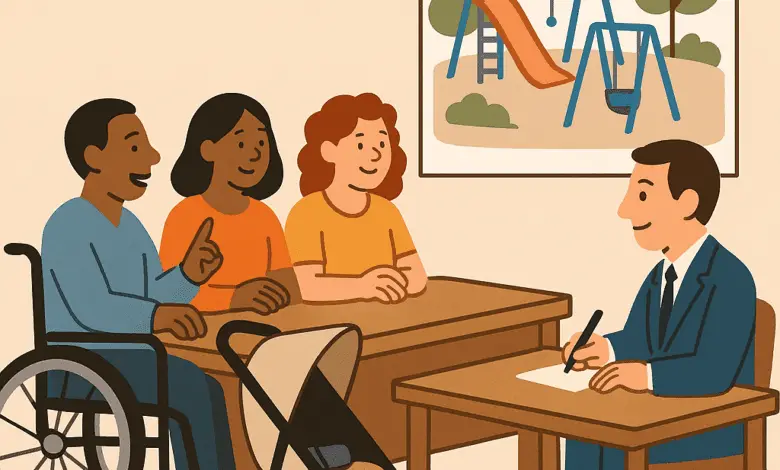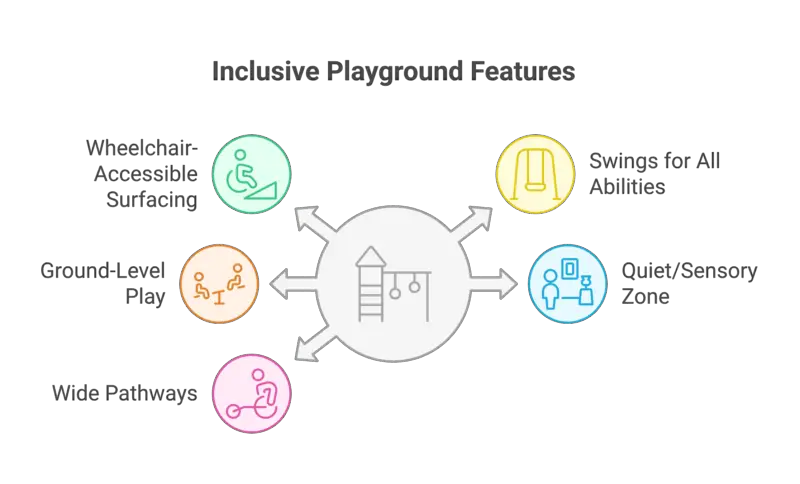
How to Advocate for an Inclusive Playground in Your Community
Tired of driving miles just to find playground equipment your child can use? You don’t need to be an expert to make local change happen. This guide walks you through every step of advocating for an inclusive playground — from knowing what to ask for to speaking up at council meetings — so your community becomes a place where all children can play together. This article is a follow up to our previous post
Key Takeaways
| Step | What You’ll Learn | Key Action |
|---|---|---|
| 1 | What makes a playground inclusive | Focus on top 5 design must-haves |
| 2 | Who controls playground decisions | Identify local decision-makers |
| 3 | How to build a strong case | Gather evidence and tell real stories |
| 4 | When to speak up | Use timing to your advantage |
| 5 | How to make your voice heard | Choose advocacy methods that suit you |
| 6 | What to say | Use ready-made templates |
| 7 | How to handle pushback | Respond to common excuses with facts |
| 8 | Success stories | Real examples of parent-led wins |
| 9 | Resources | Who can help and where to find support |
Across the UK and USA, councils are beginning to listen because families like yours are asking for inclusive play spaces. You have more influence than you might think — and this guide will help you use it.
“If we’re designing a playground for children of all abilities, including neurodivergence, then why on earth are they not fenced in? … Going to any playground is often a stressful situation because of my oldest’s habit of eloping. I’m tired of running and chasing her. Does anybody think there’s a way to petition for my city to install something like this?” Parent quote Reddit
Know What to Ask For
Before you start contacting anyone, know the basics. Councils hear from many residents, so being clear about what you want helps your message land.

Here are the top five features that make a playground truly inclusive — explained in simple, parent-friendly terms:
1. Wheelchair-Accessible Surfacing
Rubber or bonded surfaces allow wheelchairs, walking frames, and buggies to move freely. Avoid loose-fill materials like wood chips or gravel — they trap wheels and make access difficult. Reference “BS EN 1177” when you ask for surfacing specs.
2. Swings for All Abilities
Look for bucket-style swings with full support or high-backed seats with harnesses. Some councils offer “You & Me” swings where children of different abilities can swing together.
3. Ground-Level Play Options
Slides, sand tables, and play panels that can be reached from a seated position let every child take part without needing to climb.
4. Quiet or Sensory Zone
A small area with seating, shade, or sensory panels provides a space for children who need a break from noise or crowds. A nearby sensory garden is another option for this.
5. Wide Pathways
Paths between equipment should be wide enough for wheelchairs and double buggies. Smooth surfaces make a big difference for families and older people too.
Keep it simple when explaining these. You don’t need to know the technical standards — you just need to describe what works for your child and why it matters.
Here’s a recent example of a community celebrating their new inclusive playground:
Find Out Who’s In Charge
Knowing who manages playgrounds in your area saves time and frustration. Responsibilities differ slightly between the UK and the USA, but the process of finding the right contact is similar — start local, ask clearly, and keep it polite.
| Region | Who’s Responsible | How to Find Them | Quick Tip |
|---|---|---|---|
| UK | – Local Council Parks or Green Spaces Department – Parish or Town Councils (in smaller areas) – School Boards or Academies (for school playgrounds) – Housing Associations (for estate-based play areas) – Community Centres or Trusts (for shared land) |
Contact your local councillor or check your council’s website under “Parks and Open Spaces.” | Many councils list playgrounds and contact emails online. Ask who manages accessibility improvements. |
| USA | – City or County Parks and Recreation Departments – School Districts (for school playgrounds) – Homeowners’ Associations (for neighbourhood play areas) – Community Centres or Nonprofit Organisations (for shared public spaces) – State or Regional Park Authorities (for larger parks) |
Call City Hall or visit your local government website under “Parks and Recreation.” Look for public consultations or current projects. | Ask who oversees accessibility or equipment upgrades — that person can direct you quickly. |
Start with a short, friendly message asking who to contact about playground accessibility. That simple step often opens the right door and gets your advocacy moving.
Build Your Case
Now that you know what’s missing, it’s time to gather evidence and stories to show why an upgrade is needed.
Gather Evidence
- Take Photos or Videos
Show broken paths, steep ramps, or inaccessible surfacing. Visuals are powerful. - Connect with Other Families
Use Facebook or local parent groups to find others with similar experiences. - Keep a Record of Real Incidents
“My daughter can’t reach the roundabout controls” has more impact than general complaints. - Use Facts and Figures
Only about one in ten playgrounds in the UK are considered inclusive. That means nine out of ten exclude some children. In USA the situation is similar, the majority of US playgrounds meet only the minimum standards of the Americans with Disabilities Act (ADA), which generally ensures wheelchair access but not inclusive equipment or sensory-friendly features. - Share Positive Comparisons
If a nearby town has a better design, mention it: “We’d love to see something like that here.”

Explain how it affects family life — missed playdates, social isolation, siblings separated at playtime. Keep it factual but personal.
Frame It as a Community Win
Inclusive design helps everyone:
- Softer surfaces protect toddlers and prevent injuries.
- Benches and accessible paths support grandparents and carers.
- Well-designed playgrounds attract families to the area. You’re not asking for special treatment; all children have the right to good community design.
Timing Your Advocacy
Speaking up at the right time increases your chance of success. Councils plan park improvements months or even years ahead, so timing matters.
Best Times to Act
- When a new playground is being planned
- During refurbishment or replacement projects
- When councils ask for public feedback
- During budget planning seasons (usually late autumn or early winter)
How to Stay Informed
- Sign up for council newsletters and alerts about consultations
- Follow council social media accounts
- Attend community meetings or send written comments
- Join local parent or residents’ groups
If you see an announcement about park upgrades, act quickly — early involvement means your input can shape decisions before designs are finalised.
Make Your Voice Heard
There’s no single “right” way to advocate. Choose what suits your time and comfort level. Even small actions make a difference.
Low-Effort Actions
- Sign or start a petition
- Comment on council Facebook posts about playgrounds
- Fill in online consultation forms
- Share experiences in local parent forums
Medium-Effort Actions
- Send a short email or letter (template below)
- Speak at a public meeting — write down your main points to stay focused
- Request a meeting with your local councillor
- Ask local charities or disability groups to back your request
Higher-Impact Actions
- Organise a small group to attend a council meeting
- Run a simple survey asking local families what’s needed
- Partner with schools or disability organisations
- Invite councillors to visit your local inaccessible playground
Tip: Councillors are more responsive when they see children affected by poor design. Real visits can change minds faster than long reports.
What to Say
Here are ready-made templates you can adapt for different situations.
Email or Letter to Council
Dear [Council Contact],
I’m writing as a parent of a disabled child who lives in [area]. Our local playground at [location] excludes my child because [specific issue].I’m asking the council to consider [specific improvement, e.g., accessible surfacing, swing with harness].
This change would let my child play safely and enjoy the playground alongside other children. It would also benefit many families in our community.
Thank you for your time,
[Your Name]
Social Media Comment
“Exciting to see new playground plans! Will it include accessible surfacing and inclusive swings? Families with disabled children in [area] would love to be able to use it.”
Speaking at a Meeting
“My name is [Name], and my [son/daughter] uses a wheelchair. We currently travel to [other town] for an accessible playground. Could you tell us what plans exist to make our local one inclusive?”
Keep your tone calm and clear — respectful but confident.
When You Hit Obstacles
You might hear familiar responses. Here’s how to handle them.
“It’s too expensive.”
Explain that inclusive surfacing often reduces long-term maintenance and benefits all users. Councils also have access to grants for inclusive play.
“We meet minimum standards.”
Reply that legal minimums aren’t the same as inclusion. Share examples of what your child still can’t use, even if the playground is “compliant.”
“We’ll consider it in future.”
Ask politely for specifics:
- When will the next review take place?
- Can you be added to the consultation list?
- Is there a planning contact for the next phase?
Don’t Give Up
Keep all communication records. Follow up if you don’t get a response. If needed, contact:
- Your councillor’s office
- Local disability rights organisations
- Local newspapers or radio stations — they often highlight these stories
Persistence works. Most positive playground changes started with one parent who refused to give up.
Success Stories
Many communities have succeeded by speaking up.
- After a group of parents in Nottinghamshire presented their findings to the council, new accessible swings were added to three parks.
- In Westminister, a residents campaign led to inclusive surfacing being installed during a refurbishment project.
Change is possible — and it often starts with one conversation.
Resources and Useful Links
You don’t have to do this alone. Many organisations can help with information, templates, and advice.
UK Organisations
- Scope – Let’s Play Fair Campaign
This campaign specifically targets the issue of inaccessible playgrounds and provides resources for parents to take action locally. - KIDS – Making Play Inclusive
Offers practical advice and resources for making play settings accessible for disabled children.- Link: KIDS – Find A service
- Mencap – Campaigns and Community Support
Provides resources and support for local campaigns on a variety of issues affecting people with a learning disability, including community access and inclusion.
US Organisations
For more background on inclusive play and accessible park design in the US, explore the Parks for Inclusion resources from the National Recreation and Park Association